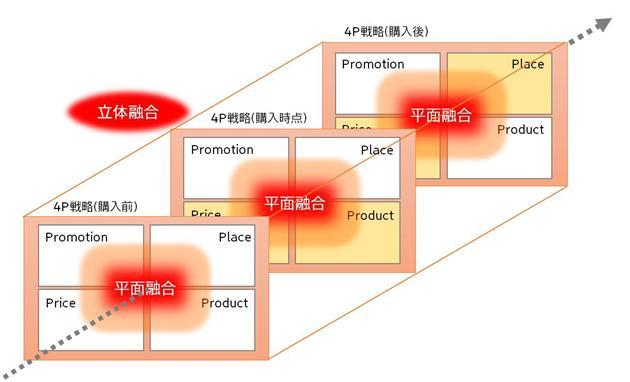This time, I will discuss the current reality where even the famous "4P" marketing framework is changing due to the advancement of "marketing technology."
The 4Ps (a framework likely familiar to Dentsu Inc. readers) represent the initials of the key marketing strategy elements: Product (goods/services), Price, Place (distribution channels), and Promotion (advertising/sales promotion). Simultaneously, many companies strategically design their organizations around these functions: "Product = Product Development/Research Department," "Price = Marketing Department," "Place = Sales Department," and "Promotion = Advertising/PR Department."
Last time, I wrote about the urgent need for collaboration between Dentsu Inc. and IT vendors due to the critical task of integrating the functions of a company's "IT department" and "marketing department." Going forward, integrating the functions across the various strategic departments of the 4Ps will also become an urgent necessity.
The next chapter will introduce case studies on 4P integration.
Flat Integration of the 4Ps
First, an example of integrating "Place" and "Promotion." A major Korean discount store launched a "Virtual Store" initiative. They installed giant posters depicting their store's product displays within subway stations. Each product photo featured a QR code. By scanning the QR code with a smartphone, customers could purchase items from the subway station and have them delivered to their homes. This initiative reportedly boosted online store sales by 130%. Beyond increasing actual subway station purchases, its strong promotional elements likely served as an "omnichannel" effort. By communicating the brand message, "We are a discount store providing convenient shopping anytime, anywhere," it probably attracted more regular e-commerce users. This initiative truly exemplifies the fusion of "Place" and "Promotion."
Next is an example that goes beyond the fusion of just two domains. A major electronics retailer developed and distributed its own price comparison app in response to customers' price comparison behavior. This app displays the product's price at the retailer's physical stores and online when the item's barcode is scanned. While this strategy is possible because the company is confident in its own pricing, if executed well, it can capture competitors' customers right in their own stores and prevent its own customers from leaving. This is a prime example of integrating "Place" and "Price," and in terms of sales promotion, it also borders on integrating "Promotion."
Another example involves attaching sensors to commercial printers that send real-time reorder signals when ink is running low. This mechanism perfectly fuses "Product," "Place," and "Promotion." Since these 4Ps form a strategic framework for the moment customers purchase goods, we call this a "flat fusion" of the 4Ps.
Three-Dimensional Integration of the 4Ps
Big data enables not only flat integration of the 4Ps but also three-dimensional integration.
Traditional 4P strategies were designed based on analyzing POS data reflecting the "point of purchase" state of goods. However, in the "experience-driven value" era, total value encompassing pre- and post-purchase experiences is prioritized, meaning the 4P framework itself should be applied to marketing strategies before and after product purchase.
For the "pre-purchase" phase, it is now possible to collect data on customer in-store browsing behavior and deliberation actions in front of display shelves. For the "post-purchase" phase, sensors attached to products can collect data on how they are being used. Utilizing this data enables the design of a "three-dimensional" 4P strategy that encompasses not only the flat, point-of-purchase 4P strategy, but also pre-purchase 4P evaluation and post-purchase upselling/cross-selling.
This differs from a 4P strategy focused solely on in-store purchase induction. Like the earlier case study of the major discount store, it signifies the necessity for a multidimensional 4P strategy that incorporates purchase induction across touchpoints beyond store visits. This strategy is precisely the "omnichannel" approach retail companies are now pursuing—a "multidimensional fusion" that combines the long-established 4P strategy framework.
For example, the recent "free model strategy" sets the "Price" at the point of purchase to zero, while designing the "Product" with long-term usage in mind. This model generates profits post-purchase through automatic replenishment of accessories regardless of "Place" and licensing agreements. It is precisely a 4P strategy that comprehensively addresses both the point of purchase and the subsequent phase.

Aiming for 4P Integration
Given the "4P integration" in the big data era discussed so far, how should companies respond? This doesn't fundamentally overturn existing marketing strategies, so there's no need to brace for drastic change. However, if we're aiming for "4P integration" focused on overall optimization rather than the individual optimization of each 4P function, as mentioned at the outset, cross-departmental collaboration within the company becomes increasingly crucial.
Next time, we will introduce specific marketing technologies that support this cross-departmental collaboration.



